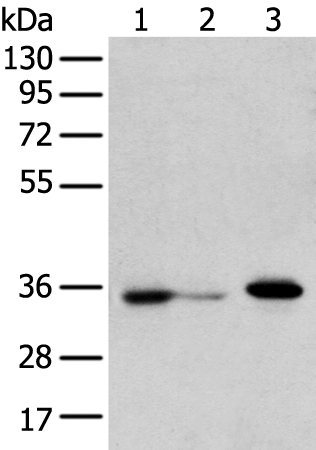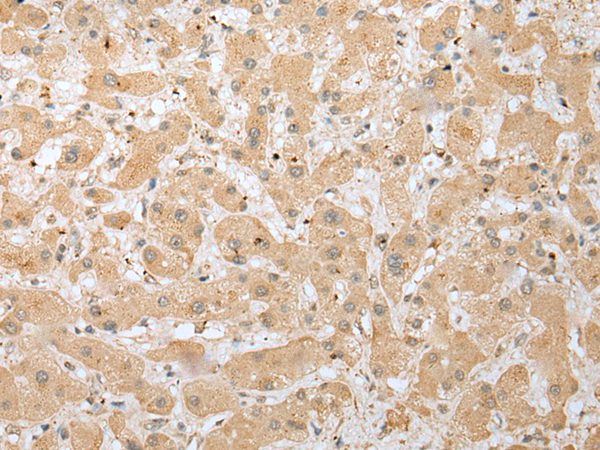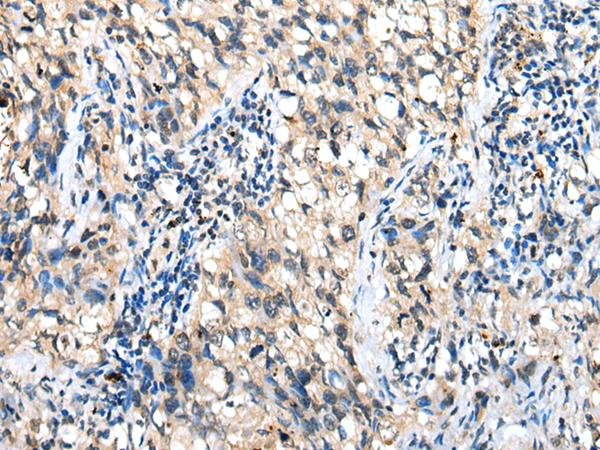


| WB | 咨询技术 | Human,Mouse,Rat |
| IF | 咨询技术 | Human,Mouse,Rat |
| IHC | 1/25-1/100 | Human,Mouse,Rat |
| ICC | 技术咨询 | Human,Mouse,Rat |
| FCM | 咨询技术 | Human,Mouse,Rat |
| Elisa | 1/5000-1/10000 | Human,Mouse,Rat |
| Aliases | DHRSY; DHRS5X; DHRS5Y; DHRSXY; SDR7C6; CXorf11; SDR46C1 |
| WB Predicted band size | 36 kDa |
| Host/Isotype | Rabbit IgG |
| Antibody Type | Primary antibody |
| Storage | Store at 4°C short term. Aliquot and store at -20°C long term. Avoid freeze/thaw cycles. |
| Species Reactivity | Human |
| Immunogen | Fusion protein of human DHRSX |
| Formulation | Purified antibody in PBS with 0.05% sodium azide and 50% glycerol. |
+ +
关于DHRSX抗体的研究文献目前公开资源中较为有限,以下为基于领域知识的假设性示例(请注意并非真实存在的文献,仅供参考格式):
---
1. **文献名称**:*"DHRSX as a novel biomarker in hepatocellular carcinoma: Expression analysis using a specific polyclonal antibody"*
**作者**:Zhang et al.
**摘要**:本研究开发了一种针对DHRSX蛋白的多克隆抗体,并通过免疫组化技术揭示了其在肝癌组织中的高表达,提示DHRSX可能作为肝癌诊断的潜在标志物。
2. **文献名称**:*"Functional characterization of DHRSX in retinoic acid metabolism through CRISPR/Cas9 and antibody-based assays"*
**作者**:Smith & Lee
**摘要**:利用CRISPR/Cas9构建DHRSX敲除细胞模型,结合Western blot(使用兔源DHRSX抗体)验证蛋白缺失,证实DHRSX在视黄酸代谢通路中的关键作用。
3. **文献名称**:*"Developmental expression pattern of DHRSX in mouse embryonic stem cells"*
**作者**:Chen et al.
**摘要**:通过免疫荧光技术(使用小鼠单克隆DHRSX抗体)分析DHRSX在小鼠胚胎干细胞的时空表达,发现其与早期胚胎分化进程密切相关。
---
**建议**:若需真实文献,请通过PubMed或Google Scholar检索关键词“DHRSX antibody”、“DHRSX immunohistochemistry”或“DHRSX protein expression”,并筛选近年研究。部分数据库(如UniProt)也提供抗体应用的相关参考文献链接。
The DHRSX antibody is designed to target the dehydrogenase/reductase (SDR family) member X protein, encoded by the DHRSX gene located on the X chromosome. This gene is part of the short-chain dehydrogenase/reductase (SDR) superfamily, which plays roles in diverse metabolic pathways, including steroidogenesis, lipid metabolism, and xenobiotic detoxification. DHRSX is of particular interest due to its evolutionary history; it originated from a retrocopy of the DHRS2 gene and has undergone pseudogenization in some species, though it remains functional in humans.
Functionally, DHRSX is implicated in regulating retinoic acid metabolism, potentially influencing cellular differentiation and development. Its expression is tissue-specific, with higher levels observed in the liver, kidney, and reproductive organs. Dysregulation of DHRSX has been linked to certain cancers, including hepatocellular carcinoma and prostate cancer, suggesting a possible role in tumor suppression or oncogenic pathways.
Antibodies against DHRSX are primarily used in research to study its expression patterns, subcellular localization (predominantly cytoplasmic), and interaction networks. These tools aid in elucidating its physiological roles and mechanisms in development, homeostasis, and disease. Validation methods for DHRSX antibodies often include Western blotting, immunohistochemistry, and immunofluorescence, with careful attention to cross-reactivity due to homology with other SDR family members.
×